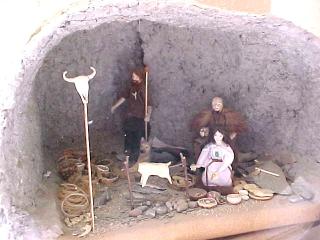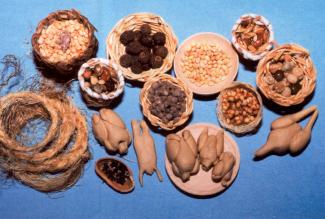The Cave
|

|
A project I had in mind right from the day I began collecting miniatures was a late ice age cave housing a stone age family, circa 10 - 12 thousand years ago.
When I first mentioned "stone age", everyone immediately said "apemen!"
No. This was not what I wanted. Homo sapiens of that era was physically indistinguishable from modern man. However, researching the era proved frustrating; all the books on "Everyday Life in the Stone Age" were very vague about so many details; the era I wanted was usually dismissed in a page, often sharing that page with the Neanderthals. |
| I'd begun to think I'd have to borrow from the Inuit culture when I came across a book about the man found in an Alpine glacier in 1990; dated as being 5000 years old, fragments of clothes were found with him and the descriptions and pictures were sufficient to give me a start - since clothes similar to those found with the corpse were, it was claimed, still being worn in some areas in this century, 5000 years later, I reckoned I could safely assume that they were also worn 5000 years previously. I also leaned a little on Jean Auel's "Clan of the Cave Bear" books, since she had obviously done her homework on the era pretty thoroughly - to the point where I think of my female doll as Ayla and the men as Jondalar and
Mamut.
I bought three dolls and dressed them in leather and a little fur, using for style a mishmash of 5000-year old Austrian/Italian, native American and Inuit. The men wear leggings, loincloths and tunics of brown or black leather, and one of them has a fur cape. Ayla wears a pale grey leather dress made by cutting a hole for her head in a large rectangle, then when it was on her, cutting away the excess leather and making seams at her sides and along the underside of her arms. I used glue, not feeling able to sew in 1/12 scale. (Come to that, I'm barely able to sew in 12/12 scale, but that's another story.) Leather
thonging, cut in half, provided belts.
|

|
In reality, of course, such a tribe would, according to anthropologists, consist of around 24 - 30 individuals - the optimum number able to live off the land inside a given area; enough to make it relatively easy to gather food, not so many as would exhaust the available resources too quickly. There would be a total age range from new-born to a grizzled 50 or so (average life expectancy was probably around 30). It was however impossible to have that many in a miniature setting unless I dropped to 1/48 or less, so I settled for a family just setting up a new cave home - possibly a father, his two offspring and their mates. At some point I may get another two adult dolls, though that would crowd the cave a bit, and I really should put in one or two children, but I'm delaying those as long as possible. I may be unusual, but I don't really want children in any of my settings! It will, however, depend on finding dolls that fit the theme.
| Using Fimo, I made several plucked and ready to cook birds, a small (skinned) animal meant to be something akin to a rabbit and a bigger one meant to be a pig. Whether they actually look like rabbit/hare and pig to anyone else is another matter! One of these birds, pre-"holed", was duly skewered onto a cocktail stick, and this, laid across two pairs of crossed sticks from the hedge, made a spit. I also made some carrots - which I think are European in origin - as well as one or two other pretty anonymous root-type vegetables. I bought several cheap baskets and removed the handles, working to the theory that simple basket weaving was something else that wouldn't alter much in ten thousand years |

|
A few cheap wooden bowls and plates, hacked a little with a craft
knife to make them look less professionally turned, joined these. The carrots,
etc, were laid in a basket, and several different kinds of bird seed were put
into baskets or bowls, carefully held in place by colourless glue. A bought
haunch of meat and a few fish lie beside the fireplace. Ayla is obviously
preparing a meal for the family as well as getting some food stored for the
winter.
Some animal shoulder blades would have been nice to have as plates, but they would have had to be something like mouse bones to be in scale, and I didn't really feel like dissecting any of the "gifts" the cat brought to the door. Some pistachio half shells were therefore added to the "kitchen" equipment to serve as plates.
A bamboo kebab skewer, 7.5 inches or so long, makes an excellent spear for the younger of the two men (Jondalar); another piece of skewer, about 1.5 inches long, provides the handle of an axe. The blade of this is a scrap of polished chert that happened to be the right shape, tied onto the handle with nylon thread which is substituting for sinew. I'm really rather pleased with it. A scrap of polished malachite, tied around with "sinew" provides a pendant for Ayla, and a bit of clear quartz gives her a knife with which she is about to start work on a carrot. Jondalar also wears a pendant, this time a shark's tooth, the smallest from a box of fossil sharks' teeth bought from a museum. (Chert is a kind of flint, and malachite, a copper ore, is probably well in keeping with the era; the Iceman had a copper axe - putting the working of metal back a good thousand years earlier than had originally been thought - and from the quality of its manufacture it seems obvious that Stone Age Man knew how to work copper a long time before 3000 BC.) The quartz, too, is a perfectly adequate substitute for flint, which was used only in those areas where flint was found. People in other areas used whatever materials were found locally for their tools - quartz, obsidian - and near Loch Tay, Scotland, there was even a "factory" that made axes from granite.
Rope dates back quite a long way, originally made of twisted grass, bark or roots. This method of making "rope" proved impossible in 1/12 scale, but the "threads" from a corn cob, dried and a) twisted and b) pleated both provided a reasonable substitute. The coils of rope are possibly a little thick to be in proper scale, but I'm quite pleased with them. I thought about a grass cape as well (the Iceman had one) but again that proved too difficult in 1/12 scale. I'm still thinking about it, though.
The older male, Mamut, is sitting on a boulder made of flint, with a few bits of flint lying around him - this is the real thing, picked up from a shingle beach in Fife. He is holding two pieces of stone, and is clearly the family flint-knapper (and probably the shaman too).
I picked up some roughly animal-shaped pieces of striped and spotted imitation fur cloth while all this was in the planning stages. These are about the right size for a tiger or leopard, and these "pelts", piled beside a wall, provide bedding for the family. A few scraps of leather lie around, either waiting to be made into something or left over from a previous job. Some tiny feathers from a bird the cat killed are there, too, as well as some cut-down quill feathers picked up during the summer. Stone age man used every part of the animals he killed.
I set it all up initially in a small room box, and I could have decorated this, either to look like a cave or the ground just outside a cave; but I had making a papier-mache cave in mind, to give the family a proper home. Trouble was, I'd never made anything in papier mache and although I knew the basics I was far from certain I could make a success of it. Then I discovered stuff called Celluclay in a craft shop - meant for model making, it was described as "instant papier mache" and struck me as exactly what I needed. It's a gray papery power containing paste, and with water added it makes a papery clay very easy to work. I added rather more water than the instructions said, however, because I wasn't wanting to make models or jewellery with it, just get a thin covering for my basic framework, and it worked very well.
I started off with a basic shape made out of chicken wire with the cut-off ends stuck into a 1" thick sheet of polystyrene - I wanted something soft enough for the "ground" to let things be stuck into it. Then I covered this with a couple of sheets of newspaper, roughly stuck into shape, and onto the wire, with glue and paperclips. First I covered the outside (top and sides) with a layer of Celluclay at most 1/4 inch thick, and let it dry before tackling the inside. For the inside, I found I had to set the whole thing on its back otherwise the weight of the Celluclay pulled the newspaper lining away from the wire and made it sag. This however meant that instead of being curved, the back of the cave ended up flat. This flattening was partially disguised by an inside "wall" two or three inches from the back, stretching halfway across the cave, which gives the impression that the cave continues round the corner; the wall was done after the rest of the inside had dried, and proved the most difficult part of the whole construction because I couldn't put pressure on the back of it to let me apply the Celluclay properly. I had to do it in segments, letting the already-dried bits support later bits.
The job initially needed 2 pound packs of Celluclay but left the outside back uncovered; I planned to use brown "landscape paper" to cover it. However, I wasn't happy with the inside wall - it looked lumpy and was fairly insecure; bits fell off too easily. I bought a third pack of Celluclay. This time I had the solidity of the previous work to provide some rigidity and was able to add a fairly smooth, thin, continuous layer which is in no danger of falling apart. Having the extra Celluclay also meant I could cover the outside back and gave me plenty additional papier mache to add one or two details that would otherwise have been left out but I think make the cave look more natural. Budgie grit and the contents of used, dried teabags scattered over some of the landscaping paper made an earthen/gravel floor.
A bought bovine skull, stuck onto another kebab skewer, stands at the mouth of the cave, the family totem. I bought a German Shepherd dog to be the wolf that Ayla tamed in the book - initially I thought the colour wrong, and that one day I'd maybe have a go at repainting it; however, a recent programme on TV about wolves showed that there is some colour variation among them, and that some are quite dark, so I think I'll leave well alone. His hair is perhaps too short, but this can pass as his summer coat. A mouse is sitting, unnoticed, quietly nibbling at the contents of one of the baskets of food; nearby are a couple of rats and a cat in hunting pose.
I have a second cave under construction - the shell is complete, but the interior needs a little more work. This one is going to be a modern shaman's 'workshop'.
********************

